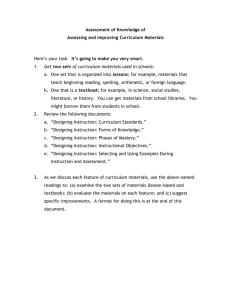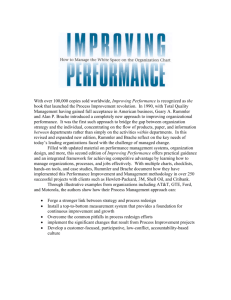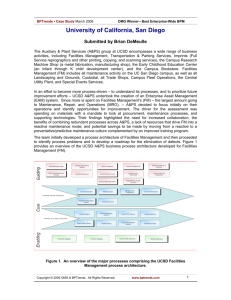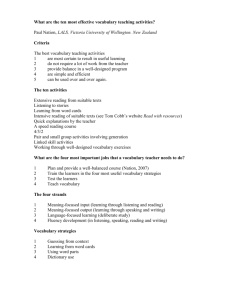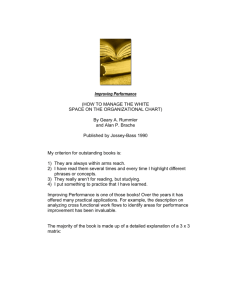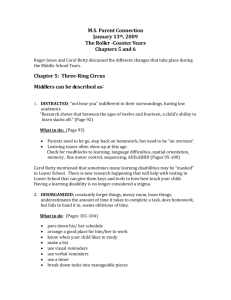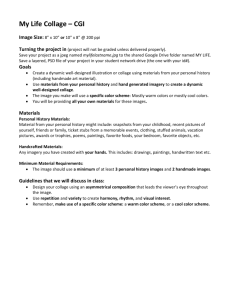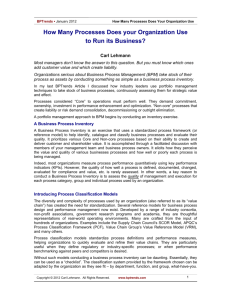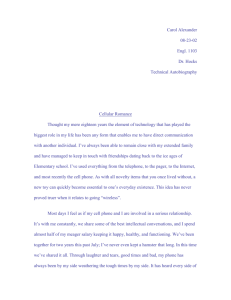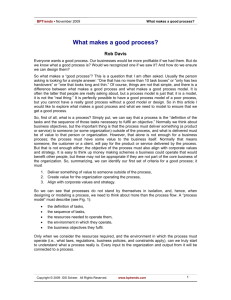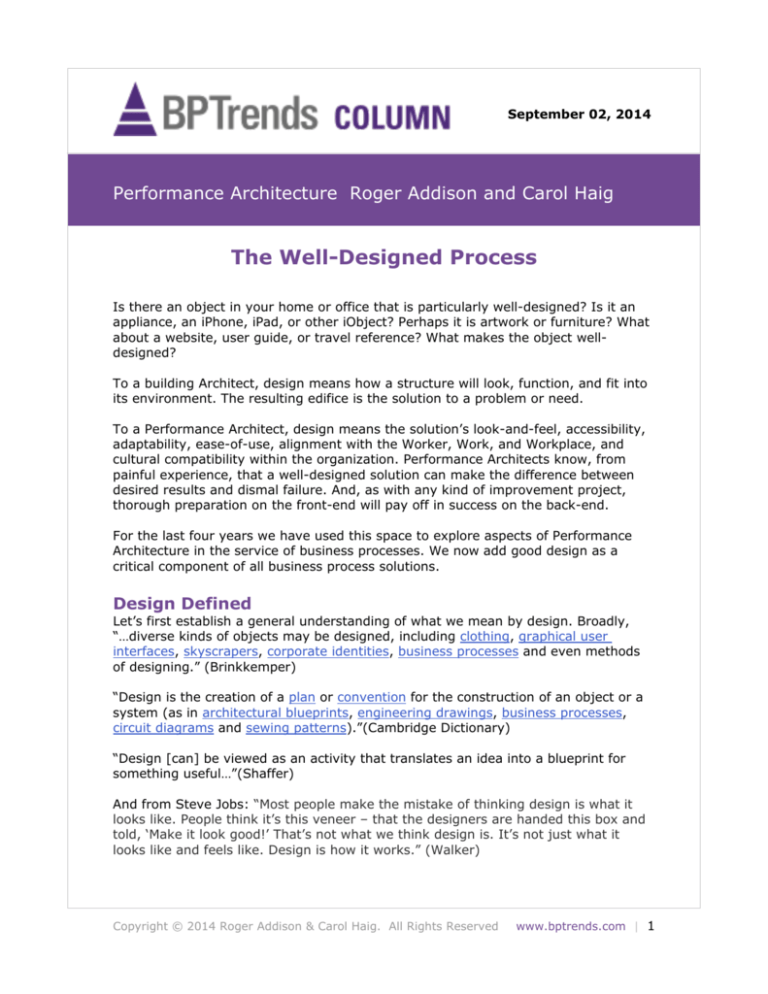
September 02, 2014
Performance Architecture Roger Addison and Carol Haig
The Well-Designed Process
Is there an object in your home or office that is particularly well-designed? Is it an
appliance, an iPhone, iPad, or other iObject? Perhaps it is artwork or furniture? What
about a website, user guide, or travel reference? What makes the object welldesigned?
To a building Architect, design means how a structure will look, function, and fit into
its environment. The resulting edifice is the solution to a problem or need.
To a Performance Architect, design means the solution’s look-and-feel, accessibility,
adaptability, ease-of-use, alignment with the Worker, Work, and Workplace, and
cultural compatibility within the organization. Performance Architects know, from
painful experience, that a well-designed solution can make the difference between
desired results and dismal failure. And, as with any kind of improvement project,
thorough preparation on the front-end will pay off in success on the back-end.
For the last four years we have used this space to explore aspects of Performance
Architecture in the service of business processes. We now add good design as a
critical component of all business process solutions.
Design Defined
Let’s first establish a general understanding of what we mean by design. Broadly,
“…diverse kinds of objects may be designed, including clothing, graphical user
interfaces, skyscrapers, corporate identities, business processes and even methods
of designing.” (Brinkkemper)
“Design is the creation of a plan or convention for the construction of an object or a
system (as in architectural blueprints, engineering drawings, business processes,
circuit diagrams and sewing patterns).”(Cambridge Dictionary)
“Design [can] be viewed as an activity that translates an idea into a blueprint for
something useful…”(Shaffer)
And from Steve Jobs: “Most people make the mistake of thinking design is what it
looks like. People think it’s this veneer – that the designers are handed this box and
told, ‘Make it look good!’ That’s not what we think design is. It’s not just what it
looks like and feels like. Design is how it works.” (Walker)
Copyright © 2014 Roger Addison & Carol Haig. All Rights Reserved
www.bptrends.com | 1
BPTrends – September 2014
The Well-Designed Process
Universal Principles of Good Design
Much study and thought has been devoted to defining good design. Dieter Rams, the
respected industrial designer, compiled a list of universal principles of good design
that helps us evaluate design quality and reminds us to use the principles ourselves:
1. Good Design Is Innovative: The possibilities for innovation are not, by
any means, exhausted. Technological development is always offering new
opportunities for innovative design. But innovative design always develops
in tandem with innovative technology, and can never be an end in itself.
2. Good Design Makes a Product Useful: A product is bought to be used. It
has to satisfy certain criteria, not only functional but also psychological and
aesthetic. Good design emphasizes the usefulness of a product while
disregarding anything that could possibly detract from it.
3. Good Design Is Aesthetic: The aesthetic quality of a product is integral to
its usefulness because products are used every day and have an effect on
people and their well-being. Only well-executed objects can be beautiful.
4. Good Design Makes A Product Understandable: It clarifies the
product’s structure. Better still, it can make the product clearly express its
function by making use of the user’s intuition. At best, it is self-explanatory.
5. Good Design Is Unobtrusive: Products fulfilling a purpose are like tools.
They are neither decorative objects nor works of art. Their design should
therefore be both neutral and restrained, to leave room for the user’s selfexpression.
6. Good Design Is Honest: It does not make a product more innovative,
powerful or valuable than it really is. It does not attempt to manipulate the
consumer with promises that cannot be kept
7. Good Design Is Long-lasting: It avoids being fashionable and therefore
never appears antiquated. Unlike fashionable design, it lasts many years –
even in today’s throwaway society.
8. Good Design Is Thorough Down to the Last Detail: Nothing must be
arbitrary or left to chance. Care and accuracy in the design process show
respect towards the consumer.
9. Good Design Is Environmentally Friendly: Design makes an important
contribution to the preservation of the environment. It conserves resources
and minimizes physical and visual pollution throughout the lifecycle of the
product.
10. Good Design Is as Little Design as Possible: Less, but better – because
it concentrates on the essential aspects, and the products are not burdened
with non-essentials. Back to purity, back to simplicity. (Rams)
Why Good Design Matters
Clearly, a lot of thought and care goes into designing something pleasing, simple,
beautiful and useful. Why, then, does good design matter?
Things that are pleasing to look at or touch encourage use – a favorite kitchen
knife, for example, may be a utensil that you reach for regularly because it is
well-balanced in the hand and cuts soft foods like tomatoes well.
Good design increases efficiency, saves time, and reduces costs – if the
technical support section of a website you access at work is easy to use and
consistently provides the information you seek, its efficiencies will translate to
increased productivity for you.
Copyright © 2014 Roger Addison & Carol Haig. All Rights Reserved.
www.bptrends.com | 2
BPTrends – September 2014
The Well-Designed Process
Good design is intuitive and reduces the need for user manuals and training –
Apple products are revered by many because they are simply and logically
designed. If you have a MacBook, for example, you will find it easy to get to know
an iPad.
Good design is competitive – a telephone service provider with well-designed
sales and service processes will attract and retain subscribers over a competitor
that is difficult to reach and inefficient in responding.
Good Design for Business Processes
As we explore what good design means for business processes, it is useful to
consider the Performance Design Lab’s definition of process:
“Process is a construct for organizing value added work to achieve a business valued
milestone so it
Can be performed effectively and efficiently
Can be managed effectively
Offers the potential for a competitive advantage” (Rummler, Ramias, Wilkins, p.
16)
This definition speaks immediately to good design because a process that produces
the desired result and does so smoothly is likely to be well-designed. It is probably
easy to manage because it is designed to be as simple and uncluttered as possible. If
the process improves worker speed, efficiency, and accuracy, then it probably
contributes to the competitive advantage of the product or service it supports.
Ultimately, a well-designed business process will add value for the end-user. It is
important that this process be as streamlined as possible without unnecessary
activities. A well-designed business process should increase the effectiveness of the
product or service, adding value for the customer, and at the same time increase
efficiency, reducing costs for the organization.
As Geary Rummler reminds us, process design benefits from a specific methodology
that should also be well-designed:
Copyright © 2014 Roger Addison & Carol Haig. All Rights Reserved.
www.bptrends.com | 3
BPTrends – September 2014
The Well-Designed Process
Figure 1. A Well-Designed Process (Rummler, Ramias, Rummler, p. 194)
The characteristics of an effective process improvement methodology, in our view,
mirror those of the resulting well-designed process:
Teachable
Repeatable
Replicable
Principle-driven
Logically sequential
Highly structured
Scalable
Addresses all elements of business process improvement
Adaptable to specific business needs (Rummler, Ramias, Rummler, p. 193)
Recipe for Good Process Design
Let’s pull together the ingredients for good process design:
The 10 Universal Principles for Good Design
The Well-Designed Process Methodology
Copyright © 2014 Roger Addison & Carol Haig. All Rights Reserved.
www.bptrends.com | 4
BPTrends – September 2014
1
2
3
4
5
6
7
8
9
10
Universal Design
Principle
Innovative
Useful
Aesthetic
Understandable
Unobtrusive
Honest
Long-lasting
Thorough
Environmentally Friendly
As Little Design As Possible
The Well-Designed Process
Application to Business Process
Find the best way to accomplish the task
Reduce steps, save time, solve problems
Strive for an elegant solution
Make it easy to follow
Leave room for the results to stand out
Keep the process focused on the results
Make the process flexible for future
improvements
Details are critical to success
Minimize waste
Concentrate on the process essentials
Table 1. Universal Design Principles Applied to Business Process
Summary
Our world is filled with designed items, both tangible and intangible. As users, we are
acutely aware of the differences between well- and poorly-designed items. Generally,
design is an activity that takes an idea and creates a blueprint for a useful item.
Good design matters. Items that are well-designed can be said to adhere to some or
all of Dieter Rams’ Universal Principles of Good Design. And, these principles can be
adapted and applied to the design of business processes. A well-designed business
process adds value for the end-user and for the organization where it is used.
References
Brinkkemper, S. (1996). "Method engineering: engineering of information systems
development methods and tools". Information and Software Technology 38 (4): 275–
280. doi:10.1016/0950-5849(95)01059-9.
Cambridge Dictionary of American English, at Dictionary.com (esp. meanings 1–5
and 7–8).
Rams, D. 10 Principles of Good Design. Retrieved from
http://www.archdaily.com/198583/dieter-rams-10-principles-of-“good-design”/
Rummler, G., Ramias, A., Rummler, R. (2010). White Space Revisited-Creating Value
Through Process. Jossey-Bass. San Francisco.
Rummler, G., Ramias, A., Wilkins, C. (2011). Rediscovering Value – Leading the 3-D
Enterprise to Sustainable Success. Jossey-Bass. San Francisco.
Shaffer, D. https://medium.com/@iamdylanshaffer/why-does-design-matterdd53ef840911, Oct. 8, 2013
Stewart, M. G. (March, 2014) Retrieved from:
https://www.ted.com/talks/margaret_gould_stewart_how_giant_websites_design_fo
r_you_and_a_billion_others_too
Copyright © 2014 Roger Addison & Carol Haig. All Rights Reserved.
www.bptrends.com | 5
BPTrends – September 2014
The Well-Designed Process
Walker, R. “The guts of a new machine.” November 30, 2003 .New York Times. Retrieved
from:
http://www.nytimes.com/2003/11/30/magazine/30IPOD.html?ex=1386133200&en=750c90
21e58923d5&ei=5007&partner=USERLAND
Authors
Roger Addison has a Ph.D. in Educational Physiology from Baylor and is Certified in
Performance Improvement Technologies (CPT). He is the co-author of Performance
Architecture and an internationally respected performance improvement consultant.
He is the founder and Chief Performance Officer of Addison Consulting. Previously he
was the Senior Director of Human Performance Improvement for the International
Society for Performance Improvement (ISPI) where he was responsible for
educational programs and implementing performance improvement systems.
Carol Haig is a Certified Performance Technologist (CPT) and has more than 30
years of multi-industry experience partnering with organizations to improve their
employees' performance. Carol is known for her superior skills in project
management, analysis and problem/opportunity identification, and instructional
design and facilitation. She has consulted with executives and line managers,
established and managed training departments, trained trainers, written for
professional publications and mentored performance consultants. She is co-author of
Performance Architecture.
Copyright © 2014 Roger Addison & Carol Haig. All Rights Reserved.
www.bptrends.com | 6

